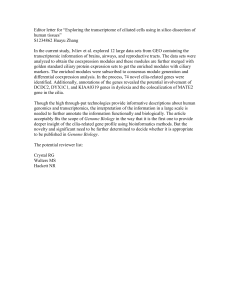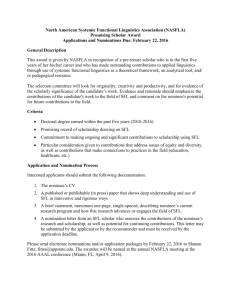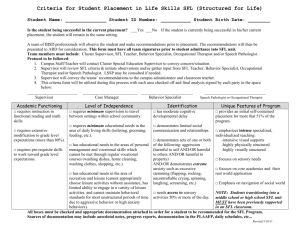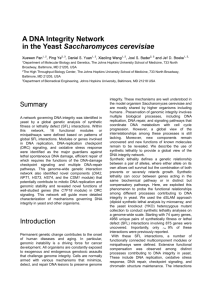A DNA Integrity Network in the Yeast Saccharomyces cerevisiae
advertisement
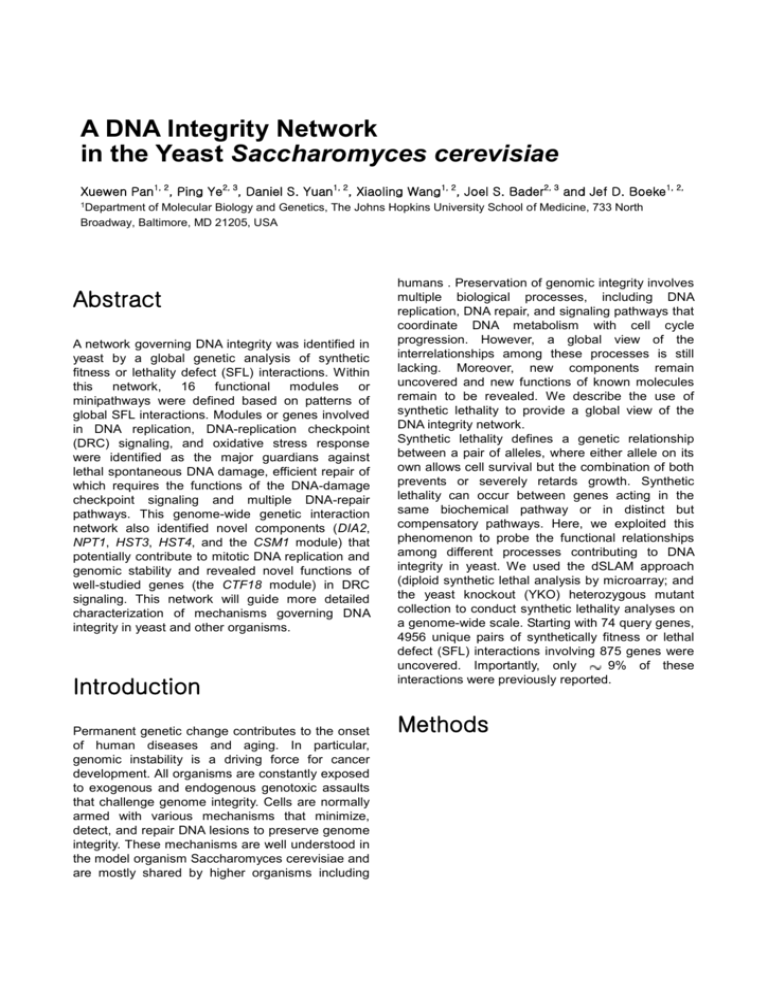
A DNA Integrity Network in the Yeast Saccharomyces cerevisiae Xuewen Pan1, 2, Ping Ye2, 3, Daniel S. Yuan1, 2, Xiaoling Wang1, 2, Joel S. Bader2, 3 and Jef D. Boeke1, 2, 1Department of Molecular Biology and Genetics, The Johns Hopkins University School of Medicine, 733 North Broadway, Baltimore, MD 21205, USA Abstract A network governing DNA integrity was identified in yeast by a global genetic analysis of synthetic fitness or lethality defect (SFL) interactions. Within this network, 16 functional modules or minipathways were defined based on patterns of global SFL interactions. Modules or genes involved in DNA replication, DNA-replication checkpoint (DRC) signaling, and oxidative stress response were identified as the major guardians against lethal spontaneous DNA damage, efficient repair of which requires the functions of the DNA-damage checkpoint signaling and multiple DNA-repair pathways. This genome-wide genetic interaction network also identified novel components (DIA2, NPT1, HST3, HST4, and the CSM1 module) that potentially contribute to mitotic DNA replication and genomic stability and revealed novel functions of well-studied genes (the CTF18 module) in DRC signaling. This network will guide more detailed characterization of mechanisms governing DNA integrity in yeast and other organisms. Introduction Permanent genetic change contributes to the onset of human diseases and aging. In particular, genomic instability is a driving force for cancer development. All organisms are constantly exposed to exogenous and endogenous genotoxic assaults that challenge genome integrity. Cells are normally armed with various mechanisms that minimize, detect, and repair DNA lesions to preserve genome integrity. These mechanisms are well understood in the model organism Saccharomyces cerevisiae and are mostly shared by higher organisms including humans . Preservation of genomic integrity involves multiple biological processes, including DNA replication, DNA repair, and signaling pathways that coordinate DNA metabolism with cell cycle progression. However, a global view of the interrelationships among these processes is still lacking. Moreover, new components remain uncovered and new functions of known molecules remain to be revealed. We describe the use of synthetic lethality to provide a global view of the DNA integrity network. Synthetic lethality defines a genetic relationship between a pair of alleles, where either allele on its own allows cell survival but the combination of both prevents or severely retards growth. Synthetic lethality can occur between genes acting in the same biochemical pathway or in distinct but compensatory pathways. Here, we exploited this phenomenon to probe the functional relationships among different processes contributing to DNA integrity in yeast. We used the dSLAM approach (diploid synthetic lethal analysis by microarray; and the yeast knockout (YKO) heterozygous mutant collection to conduct synthetic lethality analyses on a genome-wide scale. Starting with 74 query genes, 4956 unique pairs of synthetically fitness or lethal defect (SFL) interactions involving 875 genes were uncovered. Importantly, only 9% of these interactions were previously reported. Methods Results completely or partially in accord with known protein interaction studies done in yeast. Distinct Functional Modules Contributing to DNA Integrity Most biological functions are carried out by multicomponent pathways and not by isolated individual proteins. Thus, to study a biological network, it is important to first identify the pathways that carry out each biological function. Components of the same pathway tend to share similar synthetic lethality partners and synthetic lethality interactions normally do not occur between pairs of null mutations of the same linear pathway and. We use the term congruence to mathematically define the similarity in SFL interaction lists. In this study, we have identified 4956 unique SFL interactions with 74 queries; the majority of these interactions are relevant to DNA integrity maintenance available with this article online). With this data set, we first attempted to identify functionally distinct modules or linear pathways. We required that components of the same functional module (1) exhibit high congruence in genome-wide SFL interaction profiles (using an arbitrary congruence score cutoff ≥10) and/or in other mutant phenotypes such as sensitivity to exogenous DNAdamaging treatments and (2) do not exhibit direct SFL interaction with one another (between null alleles). The first criterion was used to functionally connect these components and the second to further assign them into the same or distinct modules depending on whether there is a direct SFL interaction between them. With these criteria, we defined 16 functionally distinct modules important for DNA metabolism. For simplicity, we named each module after a key component followed by an underlined m to indicate module except for modules with well-established names such as PPR (postreplication repair), HR (homologous recombination), and HIR, etc. We note that components of some modules were not used as queries in dSLAM screens and thus a genome-wide SFL profile was not available for each of them. They were included because of their physical interactions, shared SFL interaction partners, and more importantly, the lack of direct SFL interactions with other members of the same modules. The composition of the modules is highly consistent with results obtained from traditional genetic, biochemical, and physical interaction studies. For example, all 16 modules are either Discussion With these criteria, we defined 16 functionally distinct modules important for DNA metabolism. For simplicity, we named each module after a key component followed by an underlined m to indicate module except for modules with well-established names such as PPR (postreplication repair), HR (homologous recombination), and HIR, etc. We note that components of some modules were not used as queries in dSLAM screens and thus a genome-wide SFL profile was not available for each of them. They were included because of their physical interactions, shared SFL interaction partners, and more importantly, the lack of direct SFL interactions with other members of the same modules. The composition of the modules is highly consistent with results obtained from traditional genetic, biochemical, and physical interaction studies. For example, all 16 modules are either completely or partially in accord with known protein interaction studies done in yeast. References Jiang, Y.W., Veschambre, P., Erdjument-Bromage, H., Tempst, P., Conaway, J.W., Conaway, R.C., and Kornberg, R.D. (1998). Mammalian mediator of transcriptional regulation and its possible role as an end-point of signal transduction pathways. Proc. Natl. Acad. Sci. USA 95, 8538–8543. Maxon, M.E., Goodrich, J.A., and Tjian, R. (1994). Transcription factor IIE binds preferentially to RNA polymerase IIa and recruits TFIIH: a model for promoter clearance. Genes Dev. 8, 515–524. McCracken, S., Fong, N., Rosonina, E., Yankulov, K., Brothers, G., Siderovski, D., Hessel, A., Foster, S., Shuman, S., and Bentley, D.L. (1997a). 5 Capping enzymes are targeted to pre-mRNA by binding to the phosphorylated C-terminal domain of RNA polymerase II. Genes Dev. 11, 3306–3318.

